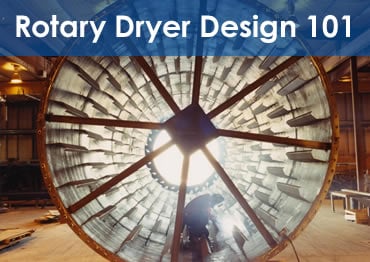Retention time, also called residence time, is the amount of time that the material must be processed in the rotary dryer in order to achieve the desired results.
The retention time required for a given application is determined through balancing the necessary process parameters – particle size distribution, air flow velocity, temperature, and more – with the desired outcome; it can then be controlled through various design parameters.
Design Parameters that Influence Retention Time
Retention time is controlled through a balance of:
Drum Diameter & Length
In general, the longer the required retention time, the longer the length of the drum that will be needed. However, drum length and diameter have an interdependent relationship, so length can vary as diameter changes.
Drum Slope & Speed
Similarly, the speed of the drum (RPM), combined with the slope of the drum, can also be used to control retention time. All dryers are set on a slight decline so gravity can assist in moving material through the unit. While the maximum recommended slope for a dryer generally falls between ¼”//ft to ⅝”/ft, depending on the circumstances, within that range, slope can be adjusted. Note: drum slope is a set parameter that cannot be changed “on the fly” once the drum is installed.
Dams
Retention time can also be controlled through the addition of dam plates. The addition of a dam plate in the dryer causes material to build up behind it (much like a dam in a river), forcing a longer retention time.
Temperature and Air Flow
In some cases, it may be possible to adjust inlet and outlet temperatures, along with the volume and speed of air moving through the drum, to affect retention time. This is less typical.
Conclusion
FEECO is the leading supplier of custom rotary dryers. All FEECO dryers are engineered around the specific requirements of the material and process goals to produce a system that operates efficiently and reliably. For more information on rotary dryer design, contact us today!



